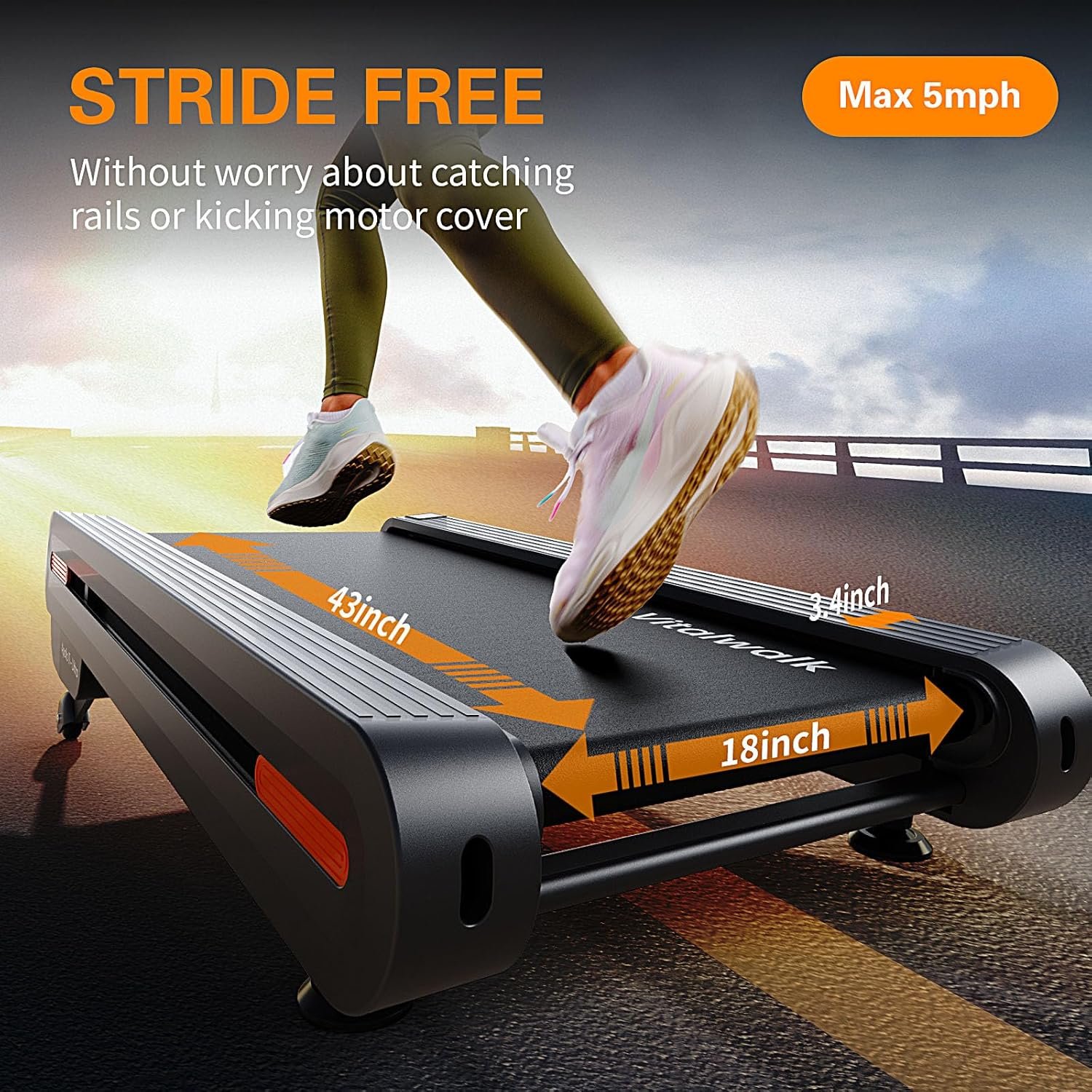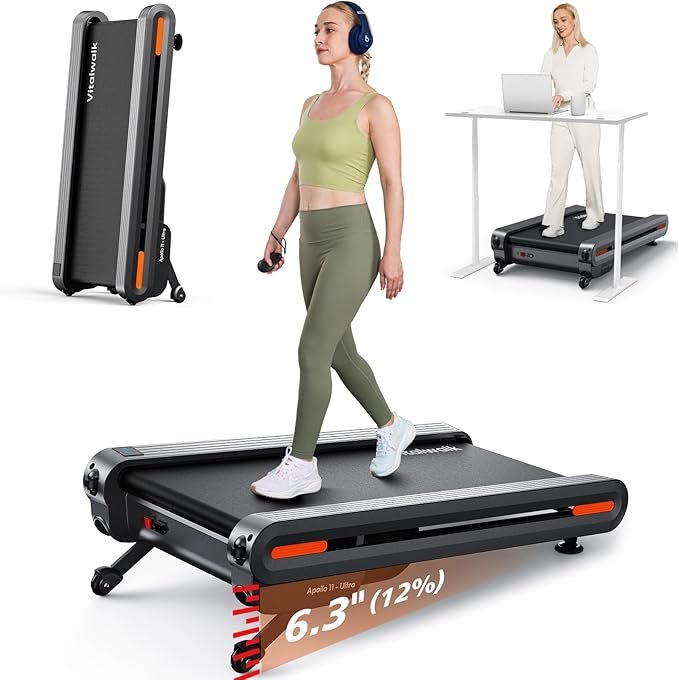The work-from-home revolution has fundamentally altered how we approach fitness. Gone are the days when exercise meant a dedicated trip to the gym – today’s reality demands equipment that seamlessly integrates into our daily lives. Enter the walking pad: a sleek solution for combating sedentary lifestyles while multitasking. However, as users have become more sophisticated, their demands have also grown, creating space for more robust machines like the Vitalwalk Apollo 11-Ultra.
Built Like a Tank: What Makes the Apollo 11-Ultra Different
The Apollo 11-Ultra doesn’t just incrementally improve on existing walking pads – it reimagines what they can be. At its heart lies a powerful 3.0 HP motor, a significant step up from the 2.5 HP motors standard in competitors like the Urevo Cyberpad. This isn’t just about numbers on paper; a stronger motor means quieter operation, better durability, and the ability to handle more demanding workouts without strain.

The “Freedom Stride Full-Deck” design features an 18-inch-wide by 43-inch-long running belt – noticeably wider than many competitors that squeeze users onto 16.5-inch surfaces. This extra space transforms the walking experience from constrained shuffling to natural striding. The design eliminates raised side rails and conceals the motor, creating an open, trip-free environment that feels more like walking on solid ground than navigating a narrow pathway.
But here’s the real game-changer: automatic incline. While most walking pads offer flat surfaces or cumbersome manual adjustments, the Apollo 11-Ultra provides six levels of automatic incline up to 12%. This single feature transforms a simple step-counter into a legitimate training tool, enabling everything from gentle slopes to challenging HIIT workouts that target different muscle groups and dramatically increase calorie burn.
The engineering extends to durability. With a reinforced double-frame structure made of alloy steel, this machine supports up to 350 pounds – significantly higher than many competitors, which typically cap out at 220-265 pounds. At 86 pounds itself, it’s substantially heavier than typical walking pads, but this weight translates directly into stability and a gym-quality feel.
Real-World Performance: The Good and the Challenging
User feedback reveals a machine that essentially delivers on its promises, with some important caveats. The overwhelming consensus is that it feels excellent and stable – owners frequently compare it to commercial gym equipment rather than typical home fitness gear. It arrives fully assembled, operates quietly enough for office environments, and the auto-incline feature responds smoothly to remote commands.
However, that 86-pound weight is a double-edged sword. While it provides unmatched stability, it makes the unit challenging to move frequently. The included wheels help, but users report they’re not quite large enough to make relocation effortless. This isn’t a flaw – it’s a deliberate trade-off between portability and stability.
The “Full-Deck” design, while providing freedom of movement, means no handrails or side supports. For users with balance concerns or those who prefer something to hold onto, this could be a deal-breaker. Additionally, like any treadmill, it requires regular maintenance – including belt lubrication and occasional adjustments- to prevent squealing or drifting.
Most concerning is an isolated but serious report of electronic glitches causing the belt to freeze, slow down, or speed up unpredictably. While this appears to be a rare occurrence, it serves as a reminder that any motorized equipment can experience failures.
The Digital Experience: Solid Hardware, Basic Software
The Apollo 11-Ultra includes a wireless remote for basic controls and connects via Bluetooth to VITALWALK’s proprietary app for progress tracking and “interactive running simulations.” Key metrics display on a clear LED screen mounted on the unit itself.
Here’s where the premium hardware meets more basic software. Unlike what many fitness enthusiasts expect today, the system doesn’t integrate with popular platforms like Apple Health, Google Fit, or Strava. For a machine targeting serious users with features like a 3.0 HP motor and automatic incline, this closed ecosystem feels like a missed opportunity. Data-conscious users who want centralized fitness tracking will find this limitation frustrating.
How It Stacks Up Against the Competition
In the walking pad arena, the Apollo 11-Ultra occupies a unique middle ground. In comparison to value options like the Urevo CyberPad, it offers superior build quality, a wider belt, a more powerful motor, and a significantly higher weight capacity. Budget alternatives, such as the Toputure TP4 (around $200), offer higher top speeds but sacrifice motor power, weight capacity, and the convenience of automatic incline.
At the premium end, brands like LifeSpan offer “buy it for life” durability at price points of $ 1,500 and above. The Apollo 11-Ultra successfully captures many premium features – particularly auto-incline and high weight capacity – at roughly one-third the cost.
The Bottom Line: Value Depends on Your Priorities
Listed at $649.99 MSRP, the Apollo 11-Ultra typically sells for $475-500, which should be considered its real price point. VITALWALK offers a standard one-year warranty, along with “lifetime technical assistance,” although the practical value of this ongoing support remains unclear.
The machine’s value proposition is entirely conditional on your specific needs. If you weigh under 250 pounds, have an average stride, and don’t prioritize incline training, less expensive alternatives offer a better value. However, if you specifically require a high weight capacity, want automatic incline capability, or prioritize a wide and stable walking surface, the Apollo 11-Ultra’s approximately $500 price represents exceptional value for features that would cost significantly more in traditional treadmills.
Who Should Buy the Apollo 11-Ultra?
This machine excels for specific users: those with higher body weights who need the 350-pound capacity and robust construction; work-from-home professionals planning semi-permanent placement who value stability over daily portability; fitness enthusiasts wanting automatic incline for HIIT workouts or trendy routines like “12-3-30”; and users who prioritize the comfort and safety of an 18-inch wide walking surface.
It’s less suitable for strict budget shoppers, apartment dwellers who require frequent relocation, individuals needing handlebar support, or data-driven users who demand integration with mainstream fitness apps.
Final Verdict
The Vitalwalk Apollo 11-Ultra successfully bridges the gap between basic walking pads and full-sized treadmills. It’s not perfect, and it’s not for everyone, but for users whose needs align with its strengths, it represents one of the most compelling values in home fitness today. In a market often dominated by either ultra-cheap basics or expensive premium options, the Apollo 11-Ultra carves out valuable middle ground – delivering serious features at a reasonable price for those ready to trade some portability for substantially better performance.
Whether you’re a work-from-home professional looking to stay active during long days, a fitness enthusiast wanting incline training without a full treadmill’s footprint, or someone who needs the confidence of a high weight capacity and rock-solid stability, the Apollo 11-Ultra deserves serious consideration. Just make sure you understand what you’re getting – and what you’re giving up – before investing.
Anil’s infectious enthusiasm and wealth of knowledge make him a natural motivator. Through his guidance and support, Anil has helped countless individuals transform their lives, empowering them to lead more vibrant and fulfilling lives.



